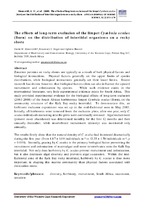The effects of long-term exclusion of the limpet Cymbula oculus (Born) on the distribution of intertidal organisms on a rocky shore

View/
Date
2009Author
Maneveldt, Gavin
Eager, Rosemary
Bassier, Aghmat
Metadata
Show full item recordAbstract
Zonation patterns on rocky shores are typically as a result of both physical factors
and biological interactions. Physical factors generally set the upper limits of species
distributions, while biological interactions generally set their lower limits. Recent
research has shown, however, that biological factors often can also influence the
upward recruitment and colonisation by species. While such evidence exists in the
international literature, very little experimental evidence exists for South Africa.
This study provided experimental evidence for the biological effects of long-term
exclusion (2003-2008) of the South African herbivorous limpet Cymbula oculus
(Born), on the community structure of the Kalk Bay rocky intertidal. To demonstrate
this, an herbivore exclusion experiment was set up in the mid-Eulittoral zone in May
2003. Initially, all herbivores were removed from the exclusion plots; after one year,
2
only C. oculus individuals recruiting into the plots were continually removed. Algal
recruitment (percent cover abundance) was determined monthly for the first 12
months and then annually thereafter, while invertebrate recruitment (density) was
monitored only annually.
The results firstly show that the natural density of C. oculus had increased
dramatically during the first year (from 4.87 ± 1.09 individuals m-2 to 12.35 ± 1.70
individuals m-2, p = 0.001). Secondly, grazing by C. oculus is the primary biological
factor preventing the recruitment and colonization of macroalgae and some
invertebrates onto the Kalk Bay intertidal. Not only does herbivory by C. oculus
prevent recruitment and colonization, but it also decreases algal diversity and
prevents algal succession. Within the mid-Eulittoral zone of the Kalk Bay rocky
intertidal, herbivory by C. oculus is thus more important in shaping this marine
community than physical factors associated with desiccation stress.
